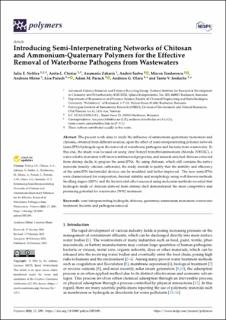| dc.contributor.author | Neblea, Iulia E. | |
| dc.contributor.author | Chiriac, Anita-L. | |
| dc.contributor.author | Zaharia, Anamaria | |
| dc.contributor.author | Sarbu, Andrei | |
| dc.contributor.author | Teodorescu, Mircea | |
| dc.contributor.author | Miron, Andreea | |
| dc.contributor.author | Paruch, Lisa | |
| dc.contributor.author | Paruch, Adam | |
| dc.contributor.author | Olaru, Andreea G. | |
| dc.contributor.author | Iordache, Tanta-V. | |
| dc.date.accessioned | 2023-09-27T11:59:51Z | |
| dc.date.available | 2023-09-27T11:59:51Z | |
| dc.date.created | 2023-02-22T16:57:17Z | |
| dc.date.issued | 2023-02-22 | |
| dc.identifier.citation | Polymers. 2023, 15 (5), 1-17. | en_US |
| dc.identifier.issn | 2073-4360 | |
| dc.identifier.uri | https://hdl.handle.net/11250/3092403 | |
| dc.description.abstract | The present work aims to study the influence of ammonium-quaternary monomers and chitosan, obtained from different sources, upon the effect of semi-interpenetrating polymer network (semi-IPN) hydrogels upon the removal of waterborne pathogens and bacteria from wastewater. To this end, the study was focused on using vinyl benzyl trimethylammonium chloride (VBTAC), a water-soluble monomer with known antibacterial properties, and mineral-enriched chitosan extracted from shrimp shells, to prepare the semi-IPNs. By using chitosan, which still contains the native minerals (mainly calcium carbonate), the study intends to justify that the stability and efficiency of the semi-IPN bactericidal devices can be modified and better improved. The new semi-IPNs were characterized for composition, thermal stability and morphology using well-known methods. Swelling degree (SD%) and the bactericidal effect assessed using molecular methods revealed that hydrogels made of chitosan derived from shrimp shell demonstrated the most competitive and promising potential for wastewater (WW) treatment. | en_US |
| dc.description.abstract | Introducing Semi-Interpenetrating Networks of Chitosan and Ammonium-Quaternary Polymers for the Effective Removal of Waterborne Pathogens from Wastewaters | en_US |
| dc.language.iso | eng | en_US |
| dc.publisher | MDPI | en_US |
| dc.rights | Navngivelse 4.0 Internasjonal | * |
| dc.rights.uri | http://creativecommons.org/licenses/by/4.0/deed.no | * |
| dc.title | Introducing Semi-Interpenetrating Networks of Chitosan and Ammonium-Quaternary Polymers for the Effective Removal of Waterborne Pathogens from Wastewaters | en_US |
| dc.title.alternative | Introducing Semi-Interpenetrating Networks of Chitosan and Ammonium-Quaternary Polymers for the Effective Removal of Waterborne Pathogens from Wastewaters | en_US |
| dc.type | Peer reviewed | en_US |
| dc.type | Journal article | en_US |
| dc.description.version | publishedVersion | en_US |
| dc.rights.holder | © 2023 by the authors. | en_US |
| dc.source.pagenumber | 1-17 | en_US |
| dc.source.volume | 15 | en_US |
| dc.source.journal | Polymers | en_US |
| dc.source.issue | 5 | en_US |
| dc.identifier.doi | 10.3390/polym15051091 | |
| dc.identifier.cristin | 2128350 | |
| dc.relation.project | Norges forskningsråd: 311882 | en_US |
| dc.relation.project | EC/H2020/817992 | en_US |
| dc.relation.project | EU/109 | en_US |
| dc.source.articlenumber | 1091 | en_US |
| cristin.ispublished | true | |
| cristin.fulltext | original | |
| cristin.qualitycode | 1 | |

